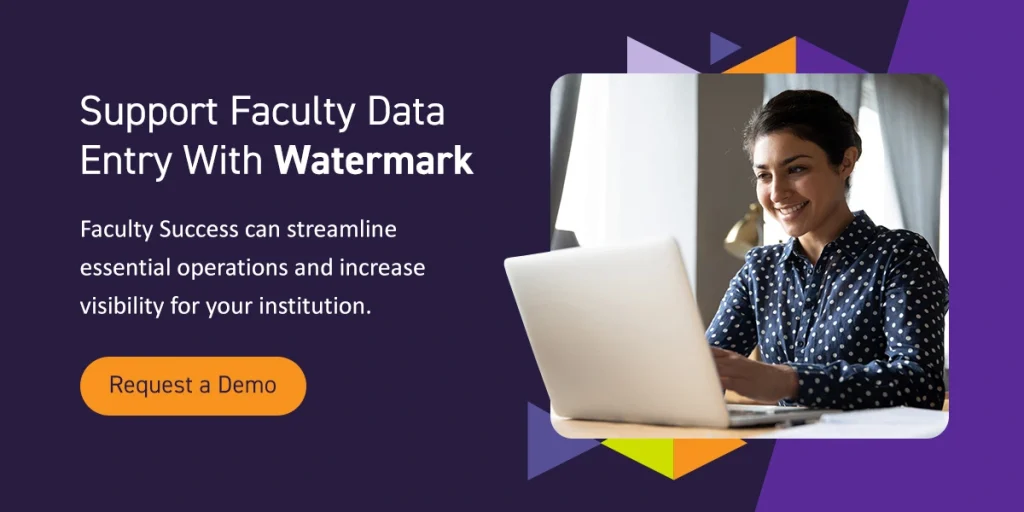




Most higher education institutions continue to struggle with collecting and reporting on comprehensive, up-to-date faculty activity information — a key requirement for accreditation, faculty reviews, promotion and tenure processes, and strategic reporting. And these activities are not optional.
The only question is: how will you do them? Without a digital solution, institutions spend too much time hunting for missing data and making numerous requests of faculty throughout the year to manually update their records.
Higher education faculty members have many responsibilities they must manage. These functions make them essential fixtures on campuses, offering vital contributions to the local and academic communities. Some essential faculty functions on campus include:
Faculty reporting helps your organization track and manage this data for administrators and faculty members. Automatic data entry and tracking can improve efficiency for your already busy professors and faculty members, so they can continue to focus on their academic ventures and students.
Additionally, your administrators and department heads can ensure information is relevant, accurate, and reliable, so they can make better judgments surrounding tenure, promotions, and other professional advancement opportunities. During annual reviews with professors, administrators can efficiently get an overview of the professor’s activity over the year and see what they have accomplished. Administrators can better understand how well faculty uphold institution standards and contribute to your campus.
“The whole idea behind Faculty Success is ‘capture data once, use it infinitely.’ It’s about collecting this information that faculty are plagued with having to provide over and over and over again — typically 6-12 times per year — furnishing the same information to different stakeholders,” said Matt Bartel, former Chief Product Officer of Watermark.
“If you’re asking faculty for basically the same information multiple times, what are the odds you’re going to get the same information over time when different people ask? And what’s the likelihood of actually getting the information when you ask? We’ve made it so that we just ask faculty for it once, and then it can be spit out of the system in different formats and templates.”
“It’s not just about efficiency — it’s about actually getting the information and having more accurate information,” Bartel said.
In a Watermark survey conducted in 2020, 69% of respondents from master’s colleges and universities indicated they’re still using paper-based, homegrown, or folder/file management solutions to manage faculty review processes. These types of processes have proven challenging as faculty and staff made the transition to remote work and online teaching, and this has accelerated the shift to digital systems for important university procedures.
“The ideal faculty activity reporting system not only eases the burden of managing massive amounts of data for administrators and staff, but puts faculty first, recognizing that the time and effort required to enter teaching, research, and service information into the system is significant.
“The bar has been set by business-to-consumer applications like TurboTax,” Bartel said. “How often are people actually interacting with Microsoft Word files in their personal lives? They fill things out on the web. This is just part of embracing technology, as, by and large, faculty now expect.”
While Faculty Success by Watermark has already helped higher education institutions across the globe streamline and simplify their faculty activity reporting and review processes, it was clear that there was a significant opportunity to save faculty time and enable administrators to get more out of the data more quickly.

Watermark’s team worked closely with its partner institutions to gather feedback on the problems they face in faculty activity reporting, and faculty buy-in was consistently named the number one challenge in getting a digital system up and running quickly. When faculty are asked to spend as much as eight hours simply entering their CV data into a database, it’s not surprising when other work takes priority.
CV Imports removes the majority of that burden from faculty by using a guided experience to streamline the process of entering the accomplishments and credentials detailed in a faculty member’s curriculum vitae. Faculty Success’ new technology makes data entry five times faster, so faculty members are free to focus their time on teaching, service, and research efforts.
“Other solutions have been very focused on trying to simplify data entry in an evolutionary manner to make things incrementally better.
“Everybody had been focused on dealing with a single item on a CV at a time. That already is the wrong paradigm,” Bartel said. “We took a different view on the problem. Our radical rethink involved looking more broadly across items.”
“We realized that there is more than one item per section, and we can save a lot of time by leveraging the fact that common things are grouped together in a section — here are all of my books, my journal articles, my presentations, my committee appointments — and they’re listed sequentially.”
The Watermark team first developed a basic prototype of CV Imports and gathered feedback from more than 100 faculty members. Their insights helped refine the concept and enhance the user interface, and an enhanced prototype was used in a formal study in the University of Minnesota’s usability lab.
This university’s lab was complete with a panel of faculty members that included both experienced users of Faculty Success and individuals who had never used a digital faculty activity reporting solution before. Watermark also established two different cohort groups of administrators and met quarterly to discuss functionality and uncover additional use cases.
“The initial 100 individuals really helped hone the design and the direction of the CV Imports interface,” said Tony Fuger, Product Manager for Faculty Success. “The usability study really helped confirm our hypothesis that this would be a material change, especially for those who had used a faculty activity reporting system in the past, and helped us identify usability issues that we were able to take care of before we got it to the development stage.
“The cohort groups helped us understand the features and functionality beyond that very specific task that would be needed to be successful on campus. We learned that just allowing faculty to upload their CV and get it into the database wasn’t enough; we also needed to add functionality to allow proxies to do it, and make sure we were catching duplicates along the way as well.”
CV Imports was initially launched to a pilot group of users, who saw significant time savings as faculty easily imported complete CVs and validated the information in around an hour, as opposed to the 8+ hours typically spent copying and pasting the information from a Microsoft Word document.
“We’ve had over 20,000 records entered into the system using the tool within the first month of launch, and users have seen up to 80% time savings,” Fuger said. “For those who have gone through the pain of having to copy and paste, it’s been revolutionary.”
Watermark’s CV Imports feature allows administrators and faculty to upload their CVs. Users can easily adjust their content, review formatting, and navigate various sections. Rather than taking a gradual approach to populating the system with more recent faculty activity data and adding to it over time, CV Imports makes it easier to support more complicated reporting objectives sooner by quickly getting complete data into Faculty Success.
Having all faculty activity information in a central repository eliminates the need for faculty to create new versions of their CV to respond to requests for information, and allows the data to be repurposed multiple ways. Administrators can use imported data and integrate additional information from integrated online databases, including Crossref, Scopus, PubMed, ORCID, and Web of Science.
Watermark has built a solution that helps create a more reliable, accurate, and complete representation of faculty accomplishments at your institution. Administrators can access this data to showcase and celebrate their faculty, strengthen decision-making, and streamline accreditation reporting.
In recognition of this drive for innovation, Faculty Success by Watermark was recently named Overall EdTech Solution of the Year by EdTech Breakthrough, a recognition of the solution’s ability to manage complex, multi-step processes while allowing users to focus on using data to drive improvements rather than simply collecting it. But the team isn’t done innovating, and more enhancements are on the horizon.
“Faculty Success and faculty activity reporting is just one piece of the puzzle. There’s a bigger framework,” Bartel said. “We’re listening to our clients and leveraging technological advances to solve the problems they face.”

Faculty Success can streamline essential operations and increase visibility for your institution. Whether your professors want to facilitate more efficient data entry or your administrators want to see faculty performance, Faculty Support by Watermark can support your institution’s needs.
Request a demo today and discover how you can leverage the power of comprehensive faculty data.





























































































































































































































































































































































































